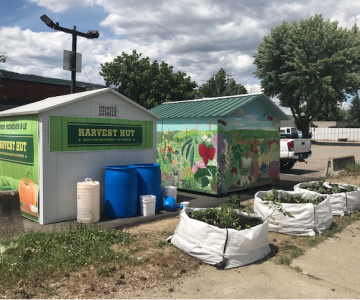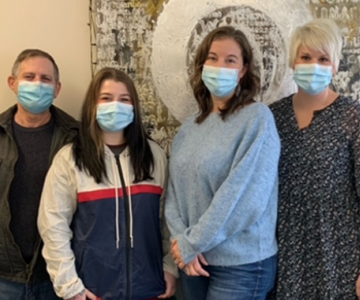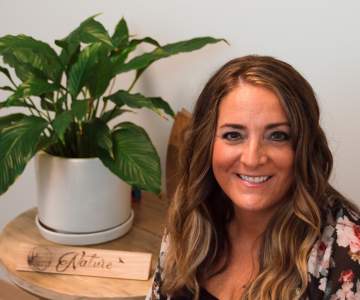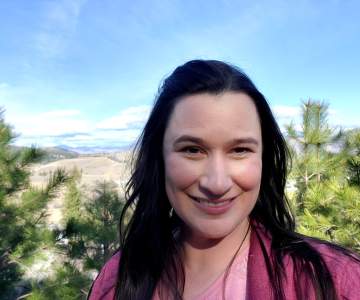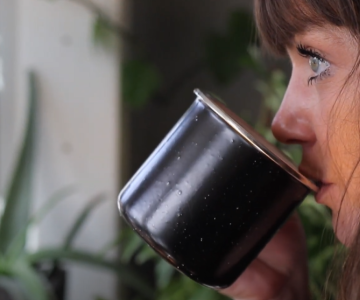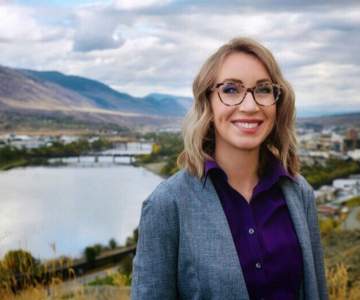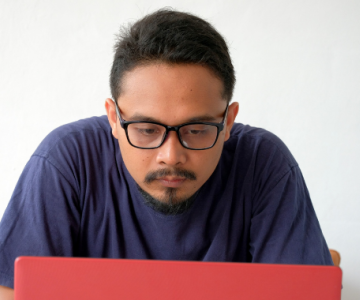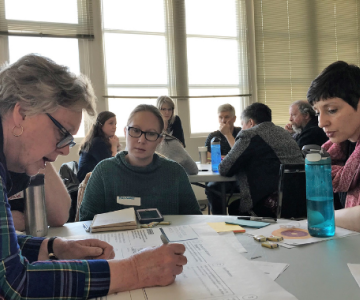Breadcrumb
Explore Stories
3 Minute Read
Community & Culture
Kootenay Boundary Regional Hospital team
The pharmacy team at Interior Health is constantly striving to be at the leading edge of health care through innovation, progression and dedication.
Whether a staff pharmacist, clinical pharmacist, pharmacy assistant or pharmacy technician, they are all part of a larger team that has been built on the foundation of support and collaboration.
2 Minute Read
Health & Wellness
Have you ever thought about ways to enhance our food systems for a healthier tomorrow? At Interior Health (IH), public health dietitians work with communities to increase food security, support food literacy and strengthen local food systems.
3 Minute Read
Health & Wellness
Members of the Kamloops Integrated Treatment Team are providing a new model of flexible, discreet and person-centred substance use treatment. Left to right: Loyd Suel, Avery Foster, Shawna Calhoun and Jen Howes.
Addiction is a highly stigmatized medical condition and people may be worried about how friends, family and employers will respond. For example, they may not want to be seen at a Mental Health and Substance Use centre. They may be worried about asking their employer for time off work. Or, they may be juggling a busy schedule caring for children or other family members.
Fortunately there is a new, flexible and discreet option for those interested in treatment for substance use in their community. Integrated Treatment Teams are now available in Kamloops, North Okanagan, Penticton, West Kelowna, and Cranbrook.
2 Minute Read
Community & Culture
Name: Randine Mariona (she/her/hers)Job Title: Mental Health & Substance Use ClinicianYears of Service: 11 yearsWorksite: North Shore Health Science CentreCommunity: KamloopsAncestral Territory: Tk’emlúps te Secwe̓pemcAdvice to live by: “What lies behind you and what lies in front of you, pales in comparison to what lies inside of you.” - Ralph Waldo Emerson
For Randine, Mental Health & Substance Use Clinician, every day is an opportunity to hear people's stories, and validate their courage and strength. She loves nothing more than to celebrate small steps they take to recover, heal and integrate their lived experiences into a model that highlights their resilience. This is what inspires her in her work as a social worker.
2 Minute Read
Research & Innovation
All nursing roles share the same end goal of caring for the health of people.
Nursing informatics is the practice and science of integrating nursing information and knowledge with technology in order to enhance health-care delivery. This benefits patients and their families, as digital health technologies enable health-care teams to provide quality care in an accessible way.
Allison Chow made the switch from outpatient nursing to nursing informatics in virtual care. She was drawn to this field of work as she recognized her nursing background aligned with her natural aptitude for, and interest in, digital technology.
A day in the life of a nursing informatics specialist brings the opportunity to collaborate with other health-care teams to enhance workflow delivery and streamline applications.
This work includes creating resources to empower health-care providers with practices to deliver effective patient-centered virtual visits. She reviews the ever-changing climate of digital health and collaborates towards making sure virtual care data is presented in a standard format and language.
She works with a variety of clinical and technical teams, including mentoring co-operative students to foster learning and promote future growth within the organization. She collaborates with other government organizations to improve access to interpreters and closed captioning for those with limited English proficiency or who are deaf, deaf-blind, or hard of hearing.
Interior Health is a large region often requiring patients to travel extensively to see their health-care providers. Virtual Care enables more flexible options and convenience when accessing care.
Interested in exploring career options at Interior Health? Check out Careers@IH
2 Minute Read
Health & Wellness
Integrated Treatment Teams offer non-judgmental, discreet and flexible substance use treatment and support in your community. Treatment can include both counselling and medications, and can be provided online or in-person depending on your goals and preference.
One of the most important and unique aspects of the team’s approach is the support provided by peers – people with personal experience with substance use who are there for you to provide advice or just listen. People like Patrick and Jessica.
2 Minute Read
Community & Culture
Medical Health Officer Dr. Carol Fenton
We know that representation matters in health care. Women hold a number of key leadership roles at IH including CEO, members of the IH board of directors, and chiefs of staff. In addition, 1,091 of the physicians with privileges at IH health-care facilities are women.
But, even with women taking an increasing role in leadership, gender bias can still be an issue.
“Before I understood how gender bias can affect referrals to medical specialists, I was definitely guilty of unconsciously perpetuating this practice,” says Dr. Shauna Tsuchiya, a physician at Royal Inland Hospital.
Dr. Tsuchiya learned that identifying as female does not automatically equate to practising female gender equality in the workplace.
“I now challenge myself and others to recognize and learn about gender biases that exist in clinical medicine and medical leadership,” she says.
Dr. Shauna Tsuchiya, a physician at Royal Inland Hospital
Medical Health Officer Dr. Carol Fenton appreciates being a member of a diverse team that recognizes gender equity as an important determinant of health. Dr. Fenton advocates for family-friendly policies—such as protected bicycling infrastructure, on-site childcare, as well as equal sharing of parental leave and domestic duties in every family.
“These types of family-friendly policies and individual choices reduce the burdens and barriers for women to succeed,” she says.
In his leadership role with physician engagement, Dr. Harsh Hundal sees a diverse workforce as fundamental to creating a strong and successful team. As the medical profession becomes more diverse, he sees a shift away from approaching solutions with a ‘we know what’s best’ mentality, towards employing a listen, learn, and co-design mindset.
“I am grateful to the articulate, thoughtful and authentic female leaders who have moved into leadership positions, thereby bringing inclusive voices to the conversation,” says Dr. Hundal. “The key is creating a community of leaders that supports each other, and accepts and learns from each other that there are different and equally valid ways of leading.”
Interior Health is proud to participate in International Women’s Day on March 8 and help #BreakTheBias. Celebrate women's achievement. Raise awareness against bias. Take action for equality.
Learn more on the IWD website
1 Minute Read
Community & Culture
Are you wondering how to stay up to date on the latest news about COVID-19, or services in your community?
New information is always being added to InteriorHealth.ca. The best way to stay in the know is to sign up for stories and updates that are delivered right to your inbox.
Check out our easy subscription options!
Stay Connected
2 Minute Read
Research & Innovation
Pictured above: a 2019 community workshop on extreme heat
It might feel like the middle of winter, but Interior Health's Healthy Communities team is hard at work helping communities prepare for the extreme heat of summer.
The interior region of B.C. is home to some of the hottest communities in Canada. Current research tells us that temperatures will continue to rise, and extreme heat events will last longer in the future.
Although each community had a different experience, the June 2021 'heat dome' impacted all of us. Extremely hot temperatures lasted for several days, and overnight temperatures remained high, offering little relief from the heat. Times like these of intense heat with no break can have many negative impacts on health, particularly for elderly people and those with existing chronic conditions. Preparing in advance for these extreme heat events will help to keep people in our communities healthy and safe during extreme weather.
Community partners are essential
Recent events have taught us that community partners such as local governments play a vital role when it comes to preparing communities for heat events and protecting the health of citizens.
Over the past four years, Interior Health has received grant funding from Health Canada and the Pacific Institute for Climate Solutions to work with communities and help them understand the health impacts of extreme heat.
Since 2018, Interior Health has developed and delivered workshops focused on responding to extreme heat. These community-focused workshops took place in Kelowna, Ashcroft, Osoyoos, Lytton, and Kamloops.
These community engagements resulted in the development of a Heat Alert & Response Planning Toolkit for Interior BC Communities to provide community partners with practical information and resources they can use when developing and implementing strategies to respond to extreme heat.
About the Healthy Communities program
We work with local governments, communities, school districts/schools and families in the Southern Interior for better health and well-being. Through engagement and advocacy we influence equity, public policies, physical and social environments and protecting the public. We know that it takes a collaborative effort to address the social determinants of health and other factors that keep us well, and health cannot be achieved by one sector alone.
Learn more about Healthy Communities
-
Load More
Showing 378 of 677
STAY CONNECTED
Receive news and alert posts, and Stories@IH blog posts, right to your inbox!


